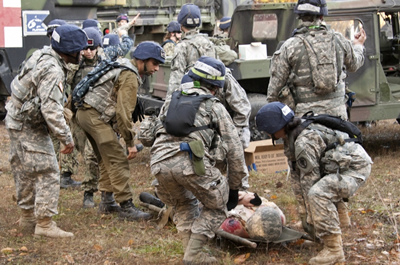Original Proposal Would Have Been Detrimental to USUHS

In the annual Operation Bushmaster, Uniformed Services University of the Health Sciences students take part in a mass casualty exercise, which augments lessons learned in classrooms and serves as the final exam for the Military and Contingency Medicine course, taken by all fourth-year School of Medicine students as well as some students in the Graduate School of Nursing. Concerns have been raised that proposed DoD budget cuts would harm or even close the university. Photo from USUHS
WASHINGTON—The DoD’s proposed plan to cut as many as 18,000 military medical billets has been put on hold in the final version of the National Defense Authorization Act, which passed the House and Senate last month. That gives at least a temporary reprieve to personnel at the Uniformed Services University of the Health Sciences and elsewhere.
DoD’s original budget proposal included a $49.5 billion allocation for military health—a 2.3% decrease from FY 2019. That decrease was driven largely through personnel cuts. DoD officials said that those positions, which include physicians, nurses, medics and administrative staff, would either be cut or go to civilians while the billets would be reallocated to combat roles. Billets refer to a specific personnel position, assignment or duty station involving one servicemember.
According to DoD officials, as the individual services’ combine their healthcare resources under the Defense Health Agency, billets dedicated to medical personnel are becoming redundant and could be better used elsewhere. At a hearing of the House Armed Services Subcommittee on Military Personnel last month, the surgeon generals of each armed service testified that they were no longer filling empty medical billets and that the 18,000 billet cut was a reflection of DoD’s realistic needs.
The cuts were expected to significantly affect USUHS, which acts as a training and proving ground for military medical personnel. University officials stated that it would be difficult, if not impossible, to replace lost professors and staff with civilians, deeply impacting the school’s function as a pipeline for healthcare workers into the military. For their four years of education at USUHS, graduates commit to serving at least seven years in the armed forces.
The final NDAA that was sent to President Donald Trump for his approval on Dec. 18 does not rule out such massive personnel cuts but does prohibit services from reducing or realigning military medical authorizations military until each service, in coordination with the chairman of the Joint Chiefs of Staff, conducts a review of medical manpower requirements.
In addition, military services would have to provide an analysis of how proposed cuts would affect overall readiness and include a plan for mitigating any potential gaps in healthcare services caused by a reduction or realignment.
Continue Reading this Article: Military Healthcare Capacity

